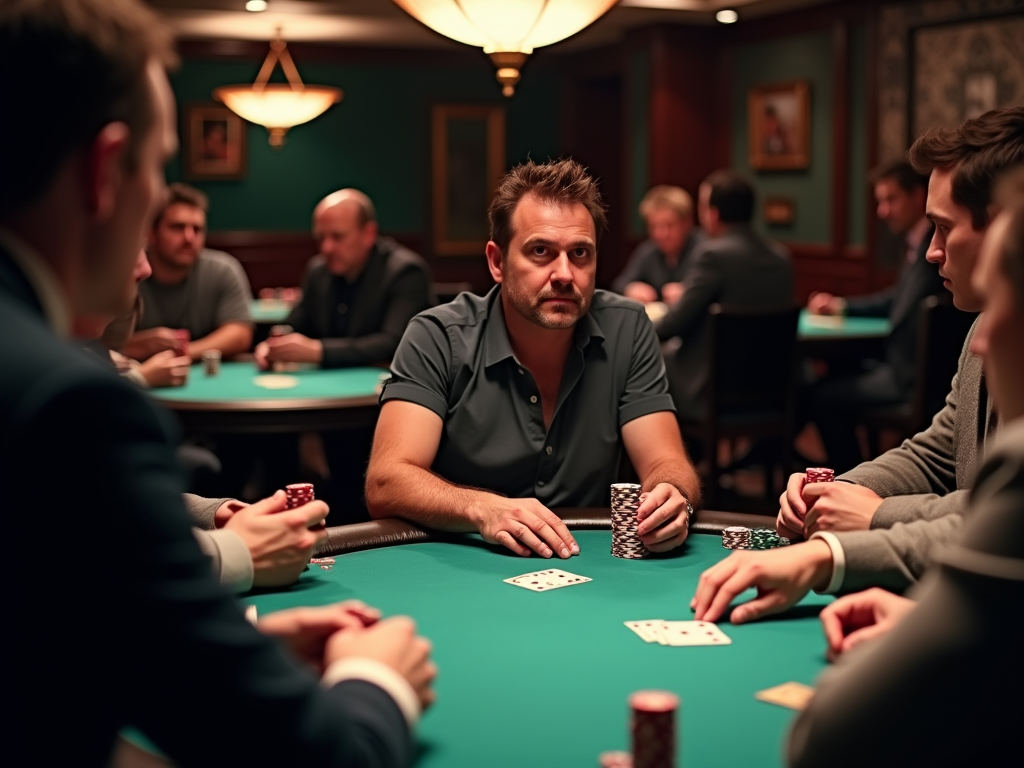Mastering Poker Bluffing: A Strategic Approach
Poker bluffing mastery requires precise timing, smart psychology, and sharp strategic thinking to win pots without premium holdings. Effective bluffs succeed through calculated position plays, accurate player reads, and strategic bet sizing—all while keeping opponents off-balance.
Key Takeaways
- Strategic timing and position are crucial factors, with late position offering the best bluffing opportunities.
- Maintaining a 2:1 ratio of value bets to bluffs helps create an unexploitable strategy.
- Target conservative players who can fold strong hands while avoiding “calling stations”.
- Create consistent betting patterns between value hands and bluffs to sell a credible story.
- Use board texture to your advantage, with dry boards offering better bluffing opportunities than coordinated ones.
Capitalizing on Position
I’ve learned that successful bluffing starts with careful position selection. Playing in late position gives me maximum information about opponents’ actions and intentions. This enhances my ability to make informed decisions and optimize bluff timing.
Consistent Bet Sizing
My bet sizing patterns stay identical between value hands and bluffs to mask my true holdings. This consistency ensures my bluffs appear credible and opponents cannot discern a pattern based on my bet sizes.
Player Targeting for Bluff Success
I focus my bluffs on observant, tight players who demonstrate an ability to fold strong hands. These players make ideal targets. In contrast, aggressive players and recreational “calling stations” make poor bluffing targets since they call too frequently and can invalidate well-crafted bluffs.
Analyzing Board Texture
Board texture analysis guides my bluff selection. Uncoordinated or “dry” boards with few draws present ideal opportunities to bluff, as opponents struggle to justify strong holdings. I avoid bluffing into draw-heavy boards, where opponents have multiple potential holdings to continue with.
Balanced Strategy: Value and Bluff Ratio
My balanced approach incorporates a studied mix of value bets and bluffs. Maintaining a **2:1 ratio** keeps my strategy profitable and difficult to counter. This disciplined framework transforms bluffing from risky guesswork into a reliable and strategic weapon in my poker game.
Why Mastering the Art of Deception is Crucial in Poker
Strategic deception through bluffing forms the backbone of winning poker. Without incorporating well-timed bluffs into your gameplay, you’ll leave significant money on the table and become predictable to observant opponents. I’ve found that mastering this essential skill can transform an average player into a formidable force at the poker table.
Key Elements of Effective Bluffing
The true power of bluffing lies in forcing opponents to make difficult decisions and fold better hands. By creating doubt in your opponents’ minds, you can win pots without having the best cards. Here are the crucial components that make bluffing an indispensable weapon in your poker arsenal:
- Strategic timing – Picking spots where your story makes sense based on the board texture and previous action
- Range balancing – Maintaining an optimal mix of value bets and bluffs to stay unpredictable
- Opponent profiling – Identifying players who fold too frequently or call too lightly
- Position awareness – Using late position to apply maximum pressure
- Bet sizing consistency – Using similar sizing for both value bets and bluffs
Game Theory Optimal (GTO) principles suggest maintaining approximately a 2:1 ratio of value bets to bluffs when making pot-sized river bets. This mathematical foundation helps create a balanced strategy that’s tough for opponents to exploit.
The beauty of masterful bluffing extends beyond just winning individual pots. It creates a table image that pays dividends when you actually have strong hands. After establishing yourself as someone capable of bluffing, you’re much more likely to get paid off when holding premium hands.
Remember that bluffing isn’t about deception for its own sake – it’s about creating profitable situations by forcing opponents into mistakes. By carefully selecting your spots and maintaining proper balance in your ranges, bluffing becomes a reliable tool for building your stack rather than a risky gambit.

Weapons in Your Bluffing Arsenal: Essential Moves to Master
Core Bluffing Techniques
I’ve found that mastering specific bluffing moves can dramatically improve your poker strategy and overall winning potential. The Continuation Bet (C-Bet) stands as one of the most reliable weapons, succeeding 50–65% of the time based on board texture. This move involves following up your pre-flop raise with a bet on the flop, regardless of whether you’ve hit your cards.
Semi-bluffing adds another layer to your arsenal by combining immediate fold equity with potential hand improvement. For instance, when holding a flush draw, you’re not just relying on your opponent folding — you’ve got backup winning chances if called.
The Stone-Cold Bluff requires perfect timing and reading abilities. This pure bluff works best when your betting pattern tells a convincing story throughout the hand, even though you’re holding nothing.
Advanced Bluffing Strategies
The Check-Raise Bluff can be particularly effective when used sparingly. By checking initially, you’re portraying weakness, making your subsequent raise more credible and harder for opponents to call. This move works best from out-of-position against aggressive players.
The Squeeze Play targets multiple opponents pre-flop. Here’s what makes it so powerful:
- It exploits dead money already in the pot
- It puts maximum pressure on the initial raiser
- It forces other players to make tough decisions with marginal hands
- It works best against loose-aggressive players who open many hands
I’ve learned that using these moves requires careful consideration of table dynamics, position, and opponent tendencies. Each technique should be used selectively and mixed into your overall strategy to maintain unpredictability.

Reading the Room: When and Where to Deploy Your Bluffs
Position and Table Dynamics
I’ve found that picking the perfect moment to bluff starts with understanding positional advantage. The Button and Cutoff spots grant me the clearest view of my opponents’ actions, making them prime locations for executing well-timed bluffs. Mastering positional play in poker can drastically improve your bluffing success rate.
Opponent profiling plays a crucial role in bluff selection. I target conservative players (often called ‘Nits’) who can fold strong hands when faced with aggression. However, I stay clear of ‘Calling Stations’ – players who rarely fold regardless of the action. My table image also affects how opponents perceive my bluffs. If I’ve shown down strong hands recently, my bluffs carry more weight.
Board Texture and Stack Considerations
The cards on the board tell me when to strike. Dry boards (unconnected cards with few drawing possibilities) create perfect bluffing opportunities since opponents struggle to make strong hands. On coordinated boards with straight or flush possibilities, I keep my bluffing frequency low.
Here are key factors I consider before executing a bluff:
- Stack depths – deeper stacks mean opponents face tougher decisions
- Number of players – heads-up pots offer higher bluff success rates
- Pot odds – ensuring my bet sizing makes mathematical sense
- Previous action – looking for signs of weakness in earlier betting rounds
- Tournament stage – late stages often see tighter play, making bluffs more effective
Stack-to-pot ratios critically impact my bluffing decisions. With deeper stacks, I can apply more pressure as opponents risk more chips to call. In short-stacked situations, players often feel pot-committed, making bluffs less effective.
The number of opponents directly affects bluff success rates. Multi-way pots significantly reduce the likelihood of all players folding, so I focus my bluffs on heads-up situations where I only need to convince one player to fold.
Making Your Story Believable: Executing the Perfect Bluff
I’ve found that a successful bluff relies on creating and maintaining a believable story through your actions. When I’m executing a bluff, I make sure my bet sizing mirrors what I’d do with my value hands — typically between 60-75% of the pot. This balanced approach prevents skilled opponents from picking up patterns that could expose my bluffing frequency.
Key Elements of a Credible Bluff
Timing is crucial in selling your story. I maintain consistent intervals between my actions whether I’m bluffing or holding the nuts. This consistency helps mask my actual hand strength and keeps opponents guessing. For example, if I typically take 3 seconds to bet with my strong hands, I’ll maintain that same timing when bluffing.
Your betting sequences need to tell a logical story across all streets. Here are the essential components that make a bluff convincing:
- Match your preflop raising range with positions and stack sizes
- Size your continuation bets consistently with both value hands and bluffs
- Scale your turn and river bets proportionally to the pot
- Target opponents who can fold better hands
- Pick spots where the board texture supports your story
In live poker games, I focus on maintaining steady breathing, relaxed posture, and controlled movements to avoid giving away physical tells. These aspects aren’t relevant in
online poker games where timing tells and betting patterns become more significant indicators.
The power of a well-executed bluff comes from building credible betting lines across multiple streets. If I’m representing a strong hand, my betting pattern needs to reflect how I’d play that actual hand from start to finish. For instance, if I’m bluffing with a missed flush draw, my bet sizing should mirror how I’d play a completed flush — maintaining similar proportions and timing throughout the hand.
A successful bluff isn’t just about one big bet — it’s about creating a consistent narrative through your actions that makes your opponents believe you have exactly what you’re representing. By paying attention to these details and maintaining balance in your play, you’ll find your bluffs becoming much more effective and profitable in the long run.
Identifying Prime Bluffing Targets
I can’t stress enough how crucial it’s to pick the right opponents when bluffing in poker. Through my experience at the tables, I’ve learned that successful bluffing starts with carefully selecting who to target based on their playing patterns and tendencies.
Key Statistics to Monitor
Stats tracking is your best friend for finding ideal bluffing targets. Here are the essential metrics I watch for:
- VPIP (Voluntarily Put Money in Pot): This shows how often a player willingly enters pots. Lower VPIP players (15-25%) tend to be more disciplined and fold to well-timed pressure.
- Fold to Continuation Bet: Players who fold over 60% to c-bets make prime bluffing targets. Their high fold frequency means they’re less likely to defend their hands.
- WTSD% (Went to Showdown): When someone shows a WTSD under 25%, they’re often willing to fold before showdown. These players make excellent bluffing targets since they rarely call down light.
- PFR (Pre-Flop Raise): A low PFR compared to VPIP indicates a passive player who calls too much. I avoid bluffing these players as they’re less likely to fold.
- Aggression Factor (AFq): This measures how often someone bets versus calls. Players with low AFq are typically calling stations – steer clear of bluffing them.
Beyond the raw numbers, timing tells can reveal a lot about hand strength. Quick calls often signal weakness while lengthy pauses followed by just calling may indicate trapped strength. I pay special attention to betting patterns in poker that reveal player tendencies and adjustments throughout a session.
The worst bluffing targets are loose-passive players and calling stations. These player types call too frequently with marginal hands and rarely fold once they’ve invested in the pot. Even a perfect bluff execution won’t work against someone who calls with any pair.
I focus my bluffs on tight-aggressive players who can fold better hands. They understand pot odds and implied odds, making them more likely to make disciplined laydowns when facing aggression. Their logical approach to the game means well-structured bluffs that tell a convincing story will often succeed.
Remember that player tendencies can shift during a session. Someone who started tight might loosen up after losses or vice versa. Stay alert to these adjustments and be ready to change your bluffing strategy accordingly.

Maintaining the Perfect Bluffing Balance
Strategic Frequency and Opponent Analysis
I recommend adjusting your bluffing frequency based on how your opponents play. When facing careful players who frequently call, I’ve found it’s smart to reduce bluffing attempts and focus more on value betting. Against overly cautious opponents who fold often, I increase my bluffing frequency to capitalize on their tendencies.
To create a balanced poker strategy, I pair each value bet with a proportional number of bluffs. This prevents skilled opponents from exploiting predictable patterns in my play. For example, if I’m betting on the river with the nuts (best possible hand) in certain situations, I need to include some strategic bluffs in similar scenarios to keep opponents guessing.
Mathematical Approach to Bluffing
The Minimum Defense Frequency (MDF) serves as my mathematical compass for bluffing decisions. This concept helps determine the optimal frequency of bluffs needed to prevent opponents from exploiting my strategy. Here’s a practical breakdown of key factors I consider:
- Pot odds guide my bluffing decisions – the larger the pot, the less frequently my bluff needs to succeed
- Position influences bluffing opportunities – late position offers more profitable bluffing scenarios
- Stack sizes affect bluffing potential – deeper stacks allow for more creative bluffing lines
- Table dynamics shape bluffing frequency – tight tables require fewer bluffs than loose ones
Bankroll management plays a crucial role in my bluffing strategy. I maintain strict control over the size of my bluffs relative to my total bankroll. This approach helps me stay profitable in the long run, even when some bluff attempts fail. Learning advanced poker techniques like proper bankroll management has helped me execute bluffs more confidently.
In multi-way pots, I reduce my bluffing frequency significantly as the likelihood of running into a strong hand increases. Instead, I focus on spots where I can tell a convincing story with my betting patterns throughout the hand. This selective approach helps maintain credibility when I do decide to bluff.
I’ve found success by varying my bet sizing when bluffing. Sometimes, a smaller bet achieves the same result as a larger one, while risking less of my stack. However, in spots where a larger bet makes more sense for my perceived range, I don’t shy away from making a bigger move.

Sources:
Book: “The Theory of Poker” by David Sklansky
Book: “Applications of No-Limit Hold’em” by Matthew Janda
Book: “Harrington on Cash Games: Volume II” by Dan Harrington and Bill Robertie
Website/Article Source: Upswing Poker
Website/Article Source: PokerNews





